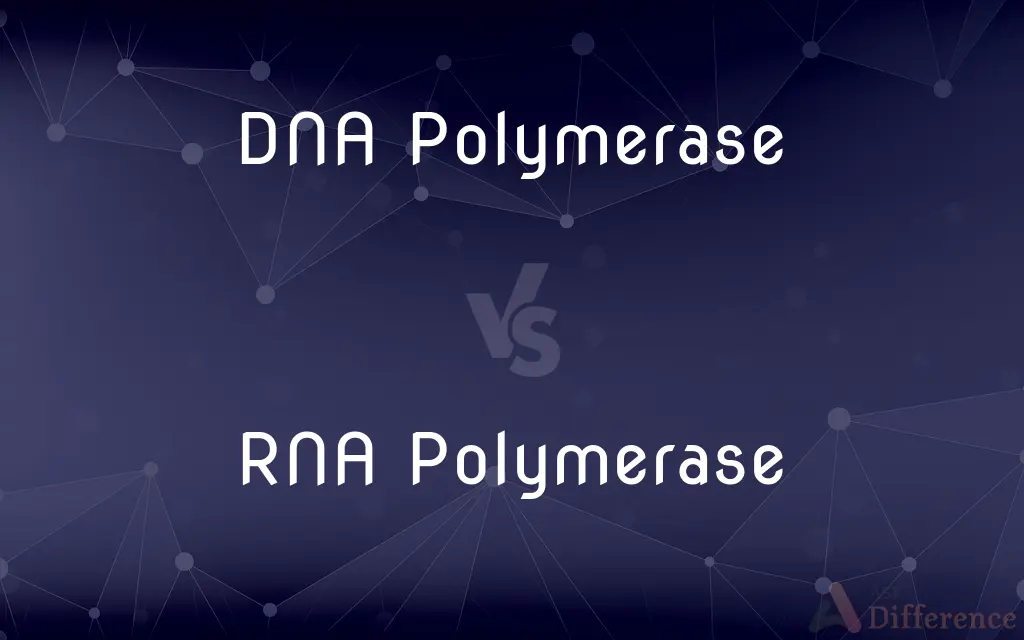DNA Polymerase vs. RNA Polymerase — What's the Difference?
By Tayyaba Rehman — Published on October 22, 2023
DNA Polymerase synthesizes DNA strands; RNA Polymerase transcribes DNA into RNA. Both are essential for genetic function.

Difference Between DNA Polymerase and RNA Polymerase
Table of Contents
ADVERTISEMENT
Key Differences
DNA Polymerase is an enzyme that plays a vital role in DNA replication. Its primary function is to synthesize new DNA strands by adding nucleotides in a sequence determined by a DNA template strand. This ensures that genetic information is accurately passed on during cell division. In contrast, RNA Polymerase is responsible for the process of transcription, where it reads the DNA sequence and synthesizes a complementary RNA strand, forming the precursor of mRNA, tRNA, or rRNA.
Focusing on their activities, DNA Polymerase not only synthesizes new DNA strands but also possesses proofreading abilities. If an incorrect nucleotide is added, this enzyme can detect the mistake and replace it, ensuring the fidelity of DNA replication. On the other hand, RNA Polymerase lacks this proofreading capability, making RNA synthesis more error-prone compared to DNA replication.
In terms of structure and types, there are several forms of both DNA Polymerase and RNA Polymerase. Various types of DNA Polymerases function in DNA replication and repair, with some specialized for leading and lagging strand synthesis. Conversely, in eukaryotes, there are three main types of RNA Polymerase (I, II, III), each responsible for transcribing different types of RNA molecules.
In the cellular context, DNA Polymerase acts during the S-phase of the cell cycle when DNA replication occurs, ensuring that each daughter cell receives a complete set of genetic information. RNA Polymerase, however, functions throughout the cell cycle, transcribing genes as needed to regulate cellular processes and respond to environmental cues.
Comparison Chart
Primary Function
DNA synthesis
Transcription of DNA into RNA
ADVERTISEMENT
Proofreading Ability
Yes
No
Types
Multiple types (e.g., Pol I, Pol II, etc.)
Mainly three types in eukaryotes (I, II, III)
Activity in Cell Cycle
S-phase
Throughout
Synthesizes
DNA strands
RNA strands
Compare with Definitions
DNA Polymerase
Functions during the S-phase of the cell cycle.
DNA Polymerase is most active when the cell is preparing to divide.
RNA Polymerase
Acts throughout the cell cycle.
RNA Polymerase can transcribe genes whenever the cell requires.
DNA Polymerase
Exists in multiple forms in cells.
Different types of DNA Polymerase have distinct roles in DNA synthesis and repair.
RNA Polymerase
Transcribes DNA into RNA.
RNA Polymerase initiates the process of protein synthesis by creating mRNA.
DNA Polymerase
Essential for genetic information continuity.
Without DNA Polymerase, genetic information could not be passed to offspring cells.
RNA Polymerase
Has distinct types in eukaryotes.
RNA Polymerase II, for instance, is responsible for mRNA transcription.
DNA Polymerase
An enzyme involved in DNA replication.
DNA Polymerase ensures accurate duplication of the genome during cell division.
RNA Polymerase
Lacks proofreading ability.
Transcription errors by RNA Polymerase are more frequent than replication errors by DNA Polymerase.
DNA Polymerase
Possesses proofreading capabilities.
If a mistake occurs during replication, DNA Polymerase can correct it.
RNA Polymerase
Key player in gene expression regulation.
By transcribing specific genes, RNA Polymerase dictates the cell's response to various stimuli.
Common Curiosities
When is DNA Polymerase most active in a cell?
DNA Polymerase is most active during the S-phase of the cell cycle.
What is the main function of DNA Polymerase?
DNA Polymerase's primary role is in DNA synthesis during replication.
Do both DNA Polymerase and RNA Polymerase have proofreading capabilities?
Only DNA Polymerase has proofreading abilities; RNA Polymerase does not.
Which enzyme is responsible for creating the RNA that gets translated into protein?
RNA Polymerase II transcribes the DNA that becomes mRNA, which is then translated into protein.
What does RNA Polymerase transcribe?
RNA Polymerase transcribes DNA into RNA, including mRNA, tRNA, and rRNA.
Do prokaryotes have different RNA Polymerases?
Prokaryotes generally have a single type of RNA Polymerase that manages all transcription.
Which enzyme requires a primer to start its synthesis?
DNA Polymerase requires a primer to initiate DNA synthesis.
Can RNA Polymerase function without a promoter?
No, RNA Polymerase requires a promoter sequence to initiate transcription.
Can errors by DNA Polymerase lead to mutations?
Yes, if DNA Polymerase makes an error that isn't corrected, it can result in a mutation.
Why is RNA Polymerase crucial for cell function?
RNA Polymerase regulates gene expression by transcribing specific genes as needed.
Are there multiple types of these enzymes?
Yes, there are various forms of both DNA Polymerase and RNA Polymerase with distinct functions.
Why is RNA Polymerase's lack of proofreading significant?
The lack of proofreading means RNA transcription can be more error-prone than DNA replication.
Which enzyme is involved in repairing DNA damage?
DNA Polymerase plays a role in DNA repair, ensuring the genome's integrity.
What are the building blocks used by DNA Polymerase?
DNA Polymerase uses deoxyribonucleotide triphosphates (dNTPs) as building blocks.
Do both enzymes use the same template strand orientation?
Both DNA Polymerase and RNA Polymerase read the template strand in the 3' to 5' direction.
Share Your Discovery

Previous Comparison
Cash Book vs. Passbook
Next Comparison
Okra vs. Lady FingerAuthor Spotlight
Written by
Tayyaba RehmanTayyaba Rehman is a distinguished writer, currently serving as a primary contributor to askdifference.com. As a researcher in semantics and etymology, Tayyaba's passion for the complexity of languages and their distinctions has found a perfect home on the platform. Tayyaba delves into the intricacies of language, distinguishing between commonly confused words and phrases, thereby providing clarity for readers worldwide.
















































